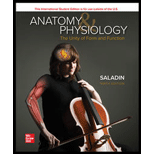
To discuss:
The steps in carbohydrate digestion from mouth to small intestine; the enzymes involved at each step and their respective contribution to carbohydrate hydrolysis.
Introduction:
The process of chemical digestion and nutrient absorption is complete when the food residues move to the cecum and exit the small intestine. There are major nutrients that are digested chemically and absorbed in the small intestine; they are carbohydrates, fats, and proteins. The most common digestible carbohydrate is starch. The starch is first converted to glucose (oligosaccharide), which is then converted to maltose (disaccharide), then maltose is converted to glucose, which is absorbed by the small intestine.
Want to see the full answer?
Check out a sample textbook solution
Chapter 25 Solutions
Anatomy & Physiology: The Unity of Form and Function
- digeetion oflipids by bile sats and lecithin, elimination Enyzmes secreted by the pancreas break down (chemically digest) ALL four types of macromolecules: Protein-digesting enzymes are called Carbohydrate-digesting enzymes are called en to aove - Lipid-digesting enzymes are called enteetni Jeme ert ho (మarrow_forwardwhat lipid is the precursor for bile synthesis. explain the role bile acids in digestion of lipids. whay are bile acids essential for digestion of lipids but not for carbohydrate digestionarrow_forwardDigestion of proteins in the stomach and intestines. Absorption of digestion products.arrow_forward
- Patient suffering from pancreatitis, explain how digestion of major nutrients (Carbohydrates, protein ,fats) are impacted?? Explain in detail all the enzymes and process that are envolved . Include types of protease and their effect . Include All the enzymes that are absent and effects.arrow_forwardA key event in the chemical digestion processes that occur within the stomach is the release of H+ and Cl– into the lumen of the stomach. Explain how the parietal cells of the gastric glands are able to produce HCl that is a million times more acidic than blood without destroying the cells themselves.arrow_forwardWe have discussed the process of digestion and absorption for all 3 macronutrients (proteins, carbohydrates, and-fats) in great detail. Now its time to test your knowledge. For this essay question write a short but concise description (story) of the digestive and absorptive process for FATS, starting from the mouth and ending when the absorbed products are in the blood of the arteries and available for utilization by the cells of the body. Asume that the starting molecule is a triglyceride and include descriptions of all mechanical and chemical digestive steps and the locations where they occur, a clear description of how the end products are absorbed into the enterocytes, and then how they get from the enterocytes to the systemic circulation.arrow_forward
- How does the mouth achieve initial digestion of polysaccharides? due to the enzymatic action of the pancreatic juices produced in the mouth through the HCl acid produced by the chief cells at the outermost oral epithelia by means of the salivary amylase which is produced by the salivary glands as a result of the chewing (mechanical digestion) of the oral muscles and the teetharrow_forwardPhysiology and Anatomy of Digestive Systemarrow_forwardThe following enzymes are involved in carbohydrate digestion in the microvilli, except? sucrase isomaltase amylase trehalasearrow_forward
- Why Pepsin is not essential for protein digestion?arrow_forwardHistological description of the major organs of digestion and its coats or layers. Explain in a long explanation Layers of stomach: Mucosa (innermost layer) Submucosa(second layer) Muscularis(third layer) Subserosa Serosa(outermost layer) Layers of liver: Outer serous layer which covers the entire liver Inner fibrous layerarrow_forwardFrom the stomach to the anal canal, the walls of every organ of the alimentary canal are made up of the same four basic layers Arrange them in order of their location starting with layer closest t lumen. O mucosa, submucosa, muscularis externa, and serosa O muscularis externa, serosa, mucosa, and submucosa O serosa, mucosa, submucosa, and muscularis externa submucosa, serosa, muscularis externa, and mucosa O serosa, muscularis externa, submucosa, mucosaarrow_forward
 Human Physiology: From Cells to Systems (MindTap ...BiologyISBN:9781285866932Author:Lauralee SherwoodPublisher:Cengage Learning
Human Physiology: From Cells to Systems (MindTap ...BiologyISBN:9781285866932Author:Lauralee SherwoodPublisher:Cengage Learning Anatomy & PhysiologyBiologyISBN:9781938168130Author:Kelly A. Young, James A. Wise, Peter DeSaix, Dean H. Kruse, Brandon Poe, Eddie Johnson, Jody E. Johnson, Oksana Korol, J. Gordon Betts, Mark WomblePublisher:OpenStax College
Anatomy & PhysiologyBiologyISBN:9781938168130Author:Kelly A. Young, James A. Wise, Peter DeSaix, Dean H. Kruse, Brandon Poe, Eddie Johnson, Jody E. Johnson, Oksana Korol, J. Gordon Betts, Mark WomblePublisher:OpenStax College




